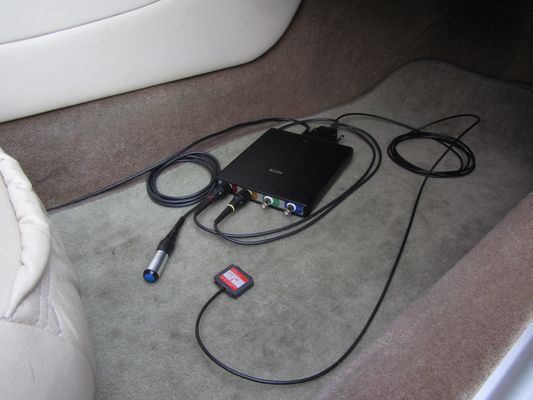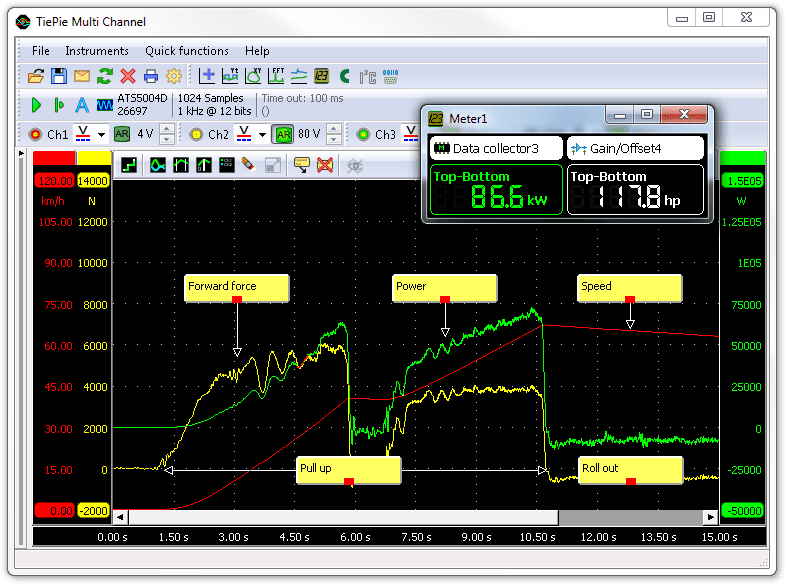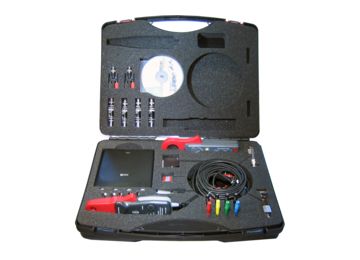What is the power measurement
To determine whether an engine is functioning properly, a power measurement can be performed to check whether the rated power output is reached. With the Accelerometer TP-ACC20 and a lab scope, an engine power measurement can be performed with a vehicle without using a dyno or other test facilities. The power measurement can be performed during the acceleration of the vehicle.
For a power measurement with an Accelerometer TP-ACC20 and a lab scope like the Automotive Test Scope ATS5004D, the vehicle acceleration and the total weight of the vehicle is used. The resulting power is the power that is actually transferred to the road and is being used to accelerate the vehicle.
How do I perform a power measurement?
To perform a power measurement with the Accelerometer TP-ACC20, first download the file below.
Connect the 25 pin D-sub connector of the Accelerometer TP-ACC20 to the extension connector at the rear of the lab scope. Connect the X-axis connector of the Accelerometer TP-ACC20 to channel 1 of the lab scope and place the accelerometer level on the floor in the vehicle with the X-axis arrow pointing opposite to the driving direction, see figure 1.

Open the file in the Multi Channel oscilloscope software and proceed as follows:
- Enter the total weight of the car, including driver and passengers, in the dialog that is presented when loading the file.
- Make sure the vehicle is stationary on a horizontal road where the power measurement can be performed without causing unsafe traffic situations.
-
Click the
 Start button or press hotkey S.
This calibrates the accelerometer and starts the measurement.
Start button or press hotkey S.
This calibrates the accelerometer and starts the measurement.
- Accelerate full throttle through first and second gear until it is time to select third gear.
- Immediate after the acceleration, let the vehicle roll out for about 4 or 5 seconds with the clutch pedal pressed or automatic gearbox in neutral.
-
Stop the measurement with the
 Stop button or hotkey S immediately after point 5.
Stop button or hotkey S immediately after point 5.
The power measurement is now ready and will look like figure 2.

The red signal in figure 2 shows the speed, yellow the forward force in Newtons and green the power in Watts. Meter 1 shows the total delivered engine power in kilowatt and horsepower. The maximum power in the graph is lower than the power given by meter 1 because that includes the power loss of the drive train, rolling friction and drag. It is important to let the car roll out after the acceleration to measure the negative power that is lost to overcome the various frictions. Because this power was also lost during acceleration, the real produced power of the engine is equal to the difference between the maximum and minimum measured power. This total power is displayed by meter 1 in figure 2.
RELATED PRODUCTS
RELATED INFORMATION
- Volkswagen Golf 4 accelerates with loud explosions
- A Golf 4 turbo GTI was having serious problems with accelerating. Accelerating from 0 to 80 km per hour would take approximately 16 seconds, which is far too long for this car. Apart from the lack of power, the engine would hold back every half second and produce a lot of explosions in the exhaust. Based on an assumption, measuring with an automotive oscilloscope was started, but it lead to no solution. When the assumption was ignored and measuring was started at the basics, the cause was found in a different area than initially was thought.




